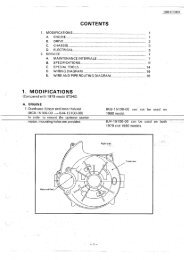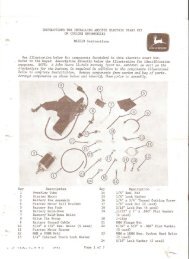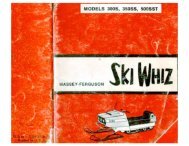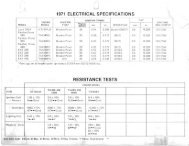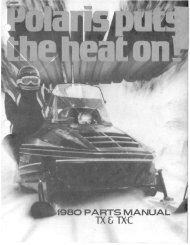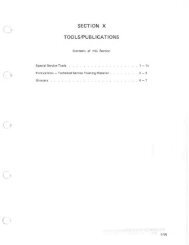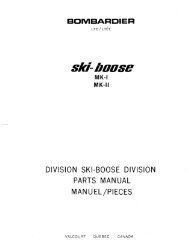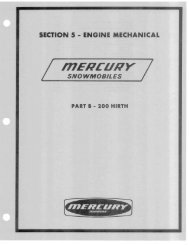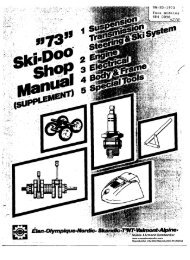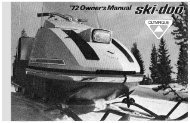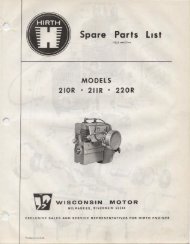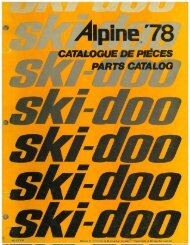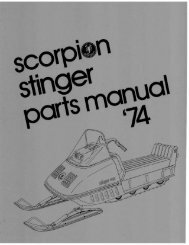1970 CCW 340 Service Manual - Vintage Snow
1970 CCW 340 Service Manual - Vintage Snow
1970 CCW 340 Service Manual - Vintage Snow
- No tags were found...
You also want an ePaper? Increase the reach of your titles
YUMPU automatically turns print PDFs into web optimized ePapers that Google loves.
engine. Overheating of the engine can cause distortion of thecylinder and cylinder head, seizing and burning of pistons,breaking of cylinder flanges and studs etc.,In addition, prolonged detonation may lead into pre-ignitionof the charge and even more serious consequences to theengine. It is essential, therefore, that detonation should berecognized and the cause eliminated as soon as possib1e.2.4.3 Most of the common causes of detonation can beeasily rectified: -1. High compression pressures. (<strong>CCW</strong> <strong>340</strong>/400 = 175-180PSI. cold at 500 RPM .)2. Incandescent points in the combustion chamber due toash deposits.3. Wrong type of spark plugs. (See Table 1-1)4. Spark plug overheated due to seat washer being worn ormissing.5. Incorrect ignition timing. (See section 5.4.4)6. Weak carburetor settings.7. High ambient temperatures. (Over 950 F.)8. Partially choked exhaust system causing high back pressure.2.4.4 PRE-IGNITION may be defined as the prematureburning of the charge due to spontaneous combustion, andbefore the specified timed ignition point by the spark plug.The resultant gas expansion, acting on the rising piston, generatesextreme temperatures and pressures in the combustionchamber and frequently results in broken pistons, bentconnecting rods, twisted or bent crankshaft and damagedbearings.Pre-ignition is usually caused by overheating and can bereadily identified by the very heavy knocking which is due togas expansion on the rising piston. It is usually preceded bydetonation, but certain conditions such as an under-sized orchoked exhaust system, will cause the engine to go straightinto pre-ignition without detonation. It is imperative that theengine should be stopped at once by closing off the air supplyto the carburetor. It will be apparent that the engine cannotbe stopped by switching off the ignition.2.5 LIGHTING SYSTEM2.5.1 Vehicle lighting is provided by lighting and batterycharging coils in the magneto, and the necessary wiring andlight switches required to operate the system.2.5.2 Operation2.5.2.1 Engines Previous to Serial Numbers:-Model <strong>340</strong>-2903614, Model 400-2809570. Typical vehiclelighting circuit, See Figure 2-11.Engines bearing serial numbers previous to <strong>340</strong>-2903614 or400-2809570 are equipped with an eight terminal ignitioncoupler. The lighting and battery charging circuits includetwo separate coil windings which produce 75 watts AC(alternating current) during magneto operation. 0 ne coilwinding supplies the power required to operate the lightingsystem and the other winding supplies the power required tocharge a 12 volt battery for use with electric started engines.MANUAL STARTED ENGINES(SeeFigu re2-4)Singleheadand tail lamp ( 12 V. 35 W-12 V. 3 W)a. The two wires from the battery charging coil winding are lamp life.2-4blue in colour. Both of these wires are routed to theignition coupler.The lighting coil winding is yellow in colour. One end isrouted to the ignition coupler and the other is grounded atthe magneto.A headlamp and tail lamp with maximum rating of 35watts may be installed on the vehicle. The wire to operatethe light switch is connected to the yellow terminal in theignition coupler.MANUAL STARTED ENGINES (See Figure 2-6)Twin headand tail lamps ( 12 V. 35 W- 12 V. 3 W).See drawing Number E <strong>340</strong>S-150. Two 12 volt, 35 watthead lamps are connected in series with the single yellow wjre.Three 12 volt, 3 watt tail (or speedometer) lights completethe circuit in a series parallel connection with a ballast resistorrated 7 ohms, 40 watts. A parallel circuit with a single poledouble throw switch is shown connected across the headlamps.In the event of a lamp failure, the switch can be placedin left or right position to provide a circuit to the remaininghead and tail lamps.N.B.-This circuit can be omitted if not required.Materials required:-Load resister 7 ohms, 40 wattsSPOT Switch, 5 amps. 1These items are available from Canadian Curtiss-Wright,Limited.ELECTRIC STARTED ENGINES. (See Figure2-5)b. On engines equipped with an electric starter, the two bluewires at the ignition coupler are plugged into a C.C.W.rectifier, part number 43-071 0-00,· and the AC is convertedto DC (direct current). The black wire is grounded.From the rectifier, DC is routed through a 7.5 ampere fuseto the battery. Power to operate the lights is taken fromthe battery.2.5.2.2 Engines with Serial Numbers Modei<strong>340</strong>-G-F2903614, Modei400-S-G-E 2809570 and Subsequenta. Engines bearing serial numbers as above are equipped witha six pole term inal coupling for the ignition and lightingcircuits. In addition, the separate lighting and batterycharging coils as per paragraph 2.5.2.1 have been changedto a single center tapped coil. The ends have beenterminated in two yellow wires and the internally centertapped ground connection has been extended by a brownwire to the terminal block.·N.B.This brown wire may be disconnected provided a satisfactoryground is maintained between the lighting circuits and theengine.The coil is rated at a nominal 12 volt 75 watt maximum andcan be connected to meet the various electrical configura·tions.1. ONE HEAD LAMP 12 V 35W- ONE TAIL LAMP 12V3WSee Figure 2-7A ballast resistor rated at 5.3 ohms 40 watts must beconnected in parallel with the head lamp to prevent lamp burnout. It will be noted from Figure 2-7 that an alternativeresistor at 7 ohms 40 watts will raise the operating voltageacross the lamp to give a better light at the cost of reduced0



